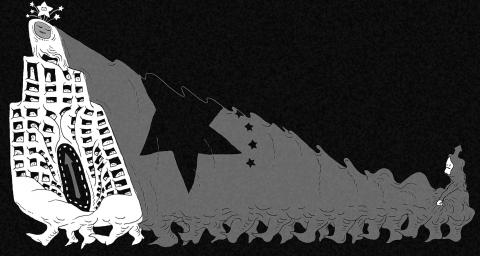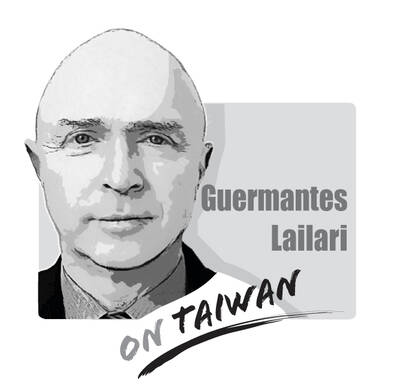The foolish man built his house upon sand; the wise man built his house on rock. The ambitious entrepreneurs of Datang chose a sturdy nylon and wool foundation.
“People always need socks,” says Xu Leile, whose company clothes the feet of the British and US armies, European hikers and pampered pet dogs.
Thanks to Xu and hundreds more like him, “Sock City” — northwest of Tie Town, east of Sweater Town — epitomized China’s economic success story. The obscure settlement in eastern Zhejiang Province became an export-driven boomtown, producing as much as a third of the world’s sock supply and thriving even through the financial crisis in 2008 and the subsequent global recession.

Last year, Datang made about two pairs of socks for every person on earth. Long and short, Argyle or polka-dotted, they cram the stores of the nearby wholesale market. In Xu’s spacious new factory, the shelves are stacked with huge reels of red, blue and orange thread.
However, ask Xu about the future and he grimaces.
“I’m very worried. This year is much worse than 2008-2009,” he says.
The biggest of his rivals to have gone under in May — the Anli Sock Group, which produced 60 million pairs of socks annually — could prove to be “the Lehman Brothers of Datang,” State Information Center chief economist Fan Jianping (范劍平) says.
Failures such as Anli’s and a slew of disappointing data in recent weeks are raising fears far beyond China that a slowdown in the world’s second-largest economy is turning into a hard landing. In the face of Europe’s woes and the weak US recovery, Chinese growth has become more important than ever: The ripples are already being felt globally, with commodities analysts blaming tumbling prices on falling demand from China.
Chinese Premier Wen Jiabao (溫家寶) has issued repeated warnings about the economy, saying growth is under pressure and exports need support. Last week’s announcement of approval for infrastructure projects, which some estimate to be worth 1 trillion yuan (US$157.75 billion), appears to be an indication of just how alarmed authorities have become about the largely investment-driven economy.
Until now, they have taken a series of milder measures, such as cutting the reserve ratio requirement and reducing interest rates, mindful of the painful hangover that resulted from the huge 4 trillion yuan stimulus they adopted to stave off the last crisis. That inflated property prices again and left a legacy of massive local government debt and questionable loans and infrastructure projects.
China’s economy saw second-quarter growth of 7.6 percent year-on-year: enviable to US or European eyes, but the lowest rate in three years, and the sixth straight quarter of slowing growth. Export growth slid to 1 percent in July — the lowest rate for three years, bar January, which was skewed by the lunar New Year holiday — and earlier this week, the official factory purchasing managers’ index fell to 49.2 — the first time since November last year that it had dropped below the 50 barrier separating expansion from contraction.
“We should be very worried,” says Anne Stevenson-Yang, co-founder of Beijing-based J Capital Research. “The economy has been in a hard landing since the fourth quarter of last year, but seems to have been helped by the consumer economy ... That’s now down as well.”
Most analysts are more optimistic, at least for now. While growth has fallen from a peak of 11.9 percent in the first quarter of 2010, when there were concerns about overheating, the decline is far less steep than last time, when it plummeted from a peak of 14.8 percent in the second quarter of 2007 to a low of 6.6 percent in early 2009.
However, Alistair Thornton of IHS Global Insight says: “More of the indicators we are looking at are showing strain and weakness. It’s nowhere near what we were looking at four years ago, but nonetheless pretty ugly. There are huge stockpiles of coal at Qinhuangdao; steel factories in Hebei are over capacity; in retail, auto dealers have two, three, four months’ more stock than they are used to.”
Cranes still tower over construction sites, but no one is working in them, says Yu Wankun, the sales manager for SANY Excavators in Jiangsu Province.
“I feel like a blossoming summer has suddenly turned into a dull winter,” he says. “In 2008, we didn’t feel the crisis at all. This year, we do feel the crisis has really struck. The government’s stimulus created a bubble, but many local governments are in debt now and the central government’s financial support has stopped.”
The knock-on effects hit people hard when exports started falling in May, says Xiao Zhou, boss of another Datang firm.
“A lot of sock companies started doing real estate in Jiangsu — they went bust because of the property market, not because of sales,” he says.
Back in the sock factory, Xu says 73 clothing firms have gone under this year, with some leaving behind debts of billions of yuan. Things have not been so bad since 2003, when foreign buyers stayed away because of the SARS crisis. Usually Xu goes to the US once a year; this time, he has made three trips — but one major customer halved its usual US$5 million order anyway. Sales to civilian customers are down by at least a fifth.
It is a sign of the times that his firm, Huazhong, considers the boom in sales to the Syrian army as a rare bright spot.
“Last year, they bought 870,000 pairs. This year it’s 960,000 already,” he says.
Few might imagine that camouflage or khaki ribbed socks came in so many varieties, but French, Singaporean and Saudi Arabian soldiers have proven exacting customers.
However, Datang also has its strengths. Smart entrepreneurs have moved away from piling high and selling cheap to targeting foreigners. Xu decided early on to focus on high-quality products and military sales, which he hoped would prove more stable and more lucrative. Though his company has dabbled in producing woolly hats, lacy tights and dog booties, Xu’s latest target is the medical market, with products such as support stockings. Others in Datang have focused on domestic consumers or sought new markets in rival developing countries.
The rise in Chinese purchases and the increase in trade to the Middle East should also help to offset problems elsewhere, says Hou Zhiping, general manager of the city’s hosiery market.
So far, there is little sign of rising unemployment — admittedly a trailing indicator — which might fuel fears of social unrest. At the labor market in nearby Yiwu, a recruiter for the Xialaite sock company grumbled about the difficulties of finding enough employees.
Geoff Crothall of China Labour Bulletin, a Hong Kong-based group supporting mainland workers, says there have been noticeably more layoffs than last year, especially in Zhejiang and Guangdong, “but nothing like 2008-2009, when 20 million workers were laid off ... I don’t think there’s a huge number of unemployed migrant workers wandering around.”
Recruiters in those provinces had previously complained of severe labor shortages, he says, and opportunities in migrants’ home provinces have improved: “Recently it was reported that, for the first time, there were more rural laborers from Sichuan working within the province than outside it.”
Beijing’s push to develop inland areas has also had some success, as Crothall says: while Zhejiang’s economy grew 5.2 percent in the first half of the year, down from 12.1 percent in the same period last year, western areas like Sichuan, Chongqing, Shaanxi and Guizhou all saw rates of above 16 percent, according to official figures.
However, growth is now slowing in those regions, too — and because their economies are so much smaller, they have less effect on the overall situation.
“You would have to triple Xinjiang’s economy to have an impact on the national picture ... If you can’t fix Guangdong, you can’t fix China,” Thornton says.
Yet, says Patrick Chovanec of Tsinghua University’s School of Economics and Management, the outlook is not uniformly negative: “This is an economic adjustment and, in the long run, will be good for China and the world, but it doesn’t mean it won’t be painful.”
Officials and analysts have long warned that the Chinese economy is unsustainable; that the years of double-digit growth were fueled by investment and exports, and that rebalancing and reform were desperately needed.
A powerful editorial in Caixin, the country’s most influential business magazine, raised fears that local governments were ignoring the center’s cautious approach and instead attempting another major stimulus that would crowd out smaller private enterprises, deter competition and increase distortions in the system.
Continuing to pursue high-speed growth, fueled by government investment, will mean that “growth will fall; discrimination will become pervasive, and rent-seeking and corruption rampant; our society and environment will be pushed to their limits; and development cannot be sustained. The mass protests, riots and environmental disasters we have seen are just some of the consequences of this distorting growth model. They are a warning,” it said. “If we continue to hanker for economic ‘miracles,’ we must be prepared to pay a high price in future.”
Additional research by Cecily Huang and Kathy Gao
A response to my article (“Invite ‘will-bes,’ not has-beens,” Aug. 12, page 8) mischaracterizes my arguments, as well as a speech by former British prime minister Boris Johnson at the Ketagalan Forum in Taipei early last month. Tseng Yueh-ying (曾月英) in the response (“A misreading of Johnson’s speech,” Aug. 24, page 8) does not dispute that Johnson referred repeatedly to Taiwan as “a segment of the Chinese population,” but asserts that the phrase challenged Beijing by questioning whether parts of “the Chinese population” could be “differently Chinese.” This is essentially a confirmation of Beijing’s “one country, two systems” formulation, which says that

“History does not repeat itself, but it rhymes” (attributed to Mark Twain). The USSR was the international bully during the Cold War as it sought to make the world safe for Soviet-style Communism. China is now the global bully as it applies economic power and invests in Mao’s (毛澤東) magic weapons (the People’s Liberation Army [PLA], the United Front Work Department, and the Chinese Communist Party [CCP]) to achieve world domination. Freedom-loving countries must respond to the People’s Republic of China (PRC), especially in the Indo-Pacific (IP), as resolutely as they did against the USSR. In 1954, the US and its allies
Indian Prime Minister Narendra Modi arrived in China yesterday, where he is to attend a summit of the Shanghai Cooperation Organization (SCO) with Chinese President Xi Jinping (習近平) and Russian President Vladimir Putin today. As this coincides with the 50 percent US tariff levied on Indian products, some Western news media have suggested that Modi is moving away from the US, and into the arms of China and Russia. Taiwan-Asia Exchange Foundation fellow Sana Hashmi in a Taipei Times article published yesterday titled “Myths around Modi’s China visit” said that those analyses have misrepresented India’s strategic calculations, and attempted to view
When Chinese President Xi Jinping (習近平) stood in front of the Potala Palace in Lhasa on Thursday last week, flanked by Chinese flags, synchronized schoolchildren and armed Chinese People’s Liberation Army (PLA) troops, he was not just celebrating the 60th anniversary of the establishment of the “Tibet Autonomous Region,” he was making a calculated declaration: Tibet is China. It always has been. Case closed. Except it has not. The case remains wide open — not just in the hearts of Tibetans, but in history records. For decades, Beijing has insisted that Tibet has “always been part of China.” It is a phrase